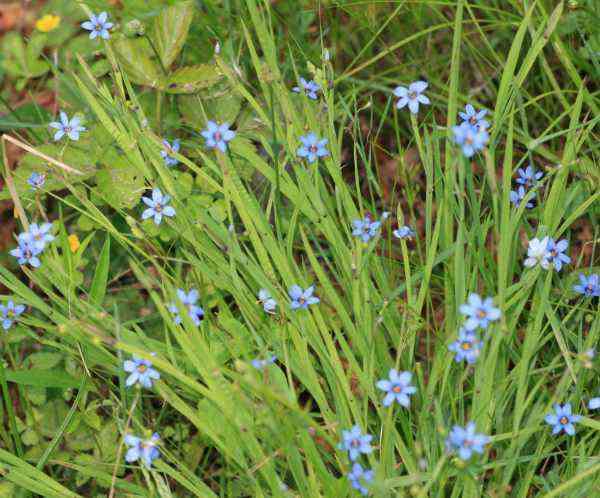Blue-eyed Grass
Photo:
SB_Johnny, CC BY-SA 3.0, via Wikimedia Commons
The Blue-eyed Grass, Sisyrinchium montanum, is a lovely perennial flower which has long been a favourite plant due to its attractiveness and ease of care. It blooms in the spring and gets its common name from its sparse foliage, which resembles grass blades. In the late spring and early summer, the leafy clusters are complemented by clusters of blue, purple, or white flowers. It grows natively in large parts of in North America, from southern Quebec to southern British Columbia, south to New Jersey to northern Indiana, around the Great Lakes region, through the Dakotas, Montana, and New Mexico, and into the Rocky Mountains.
Blue-Eyed Grass Sisyrinchium montanum can be a shy retiring plant at times. They are small perennials only 10-30 cm tall (4-12”), with narrow leaves to 3mm wide (1/8”). They start opening their eyes in early June and continue to look around all through June.
Quick Growing Guide
Botanical Name: Sisyrinchium montanum
En français: Herbe aux yeux bleu
Sun / Shade:
Water: Dry to moist
Height:
Care:
Appearance
Blue-eyed grass is a simple-to-grow plant that does best in moist, well-drained soil, full sun or partial shade, and both. When planted in organically rich soil, it grows as a dense stand of strong, dark green foliage. Depending on the species and area, flowers begin to appear in late spring or early summer atop a short stalk that raises them just over the top of the foliage. The six petals of the cheery blue or purple flowers have a bright yellow center. The iris family is known for its fan-shaped clumps of foliage.

Planting and Growing Blue-eyed Grass
When the soil is moist and has good drainage, blue-eyed grass can be grown pretty easily, even in relatively poor soil. Small groups of plants will use rhizomes and self-seeding to quickly expand and establish ground-cover colonies. When the blue-eyed grass has finished flowering, cut it back to prevent it from self-seeding and expanding. You may end up with a thriving colony of them in 4 or 5 years.
Every two to three years, divide blue-eyed grass to rejuvenate it and encourage the growth of new plants. Insects, illnesses, and even deer generally don’t touch this plant and tend to avoid it.
Soil
Poor to mediocre soil is preferable for blue-eyed grass, but it also has to be moist and well-draining. It prefers soil with a pH of 5.0 to 7.0 that is acidic or neutral. For this reason, the plants have a lanky character in particularly rich soil.
Light for Sisyrinchium montanum
Blue-eyed grass does best in full or partial light, but too much shadow can prevent it from blossoming. Full sun is typically defined as having 6 to 8 hours per day of direct sunshine, whereas the partial sun is defined as having 4 to 6 hours per day. If there aren’t any sections of your garden that get all-day sun, try to give your blue-eyed grass at least 5 to 6 hours of direct sunlight per day. Remember that the daylight hours don’t have to be consecutive. A few hours of direct sunshine in the morning, some shade at lunch, and a few more hours in the afternoon will also be effective.
Water
The ideal soil for blue-eyed grass is moist and does not dry out. That suggests that it might require additional watering more regularly than your other perennials. When the soil feels dry to the touch, check the soil often and water your blue-eyed grass. The best times to water blue-eyed grass are early in the morning or late at night. Watering in the middle of the day could harm the leaves. Watering plants in the early morning and late evening helps them retain the moisture they require to withstand the heat of the day and reduces moisture loss due to evaporation.
Normally, mulching the soil is a wonderful way to keep it wet, but with blue-eyed grass, mulch covering the root crowns might promote rot. For this reason, keep mulch and compost far away from the plant’s leaves and stems.
Fertilizer
To improve soil, compost can be applied seldom, but even that is frequently unnecessary. The plant favors poor soil conditions. Thus, chemical fertilizers shouldn’t be used. Lanky plants might arise from over-fertilization.
Pruning Blue-eyed Grass
After blooming is finished, blue-eyed grass colonies can be cut back to prevent undesired self-seeding. Although it is not necessary, some gardeners like to deadhead the spent blooms to encourage new buds and a longer bloom time.
Where to Plant
It can be found in meadows and along borders in nature. They frequently grow in areas where there is little competition from other plants. They prefer moist, well-drained soil in full sun, half shade, or full shade, but can withstand drought. Blue-eyed grass can be found on roadsides, meadows, and prairies. You can also grow them yourself under the right conditions.
Medicinal Uses
Sisyrinchium species have a long history of medical use. Native Americans brewed tea from its roots to treat a variety of ailments, including encouraging regular bowel movements, alleviating hay fever, assisting with diarrhoea, and treating intestinal worms and stomach aches. They are a traditional Appalachian remedy for fever and chills. Teas have been used to treat menstrual disorders as well as laxatives and birth control.
Companion plant suggestions include Pussy Toes, Three Flowered Avens, Purple Prairie Clover, White Aster, June Grass, and Side Oats Grama Grass.







Leave a Reply
You must be logged in to post a comment.